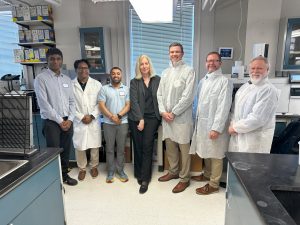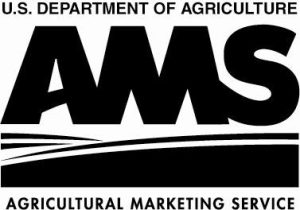Newly appointed Federal Environmental Protection Agency (EPA) Region IX Administrator Josh Cook came to the Valley this week to meet with agricultural groups to discuss critical air quality issues. Coordinated by the Nisei Farmers League and co-hosted by the California Cotton Ginners and Growers Association (CCGGA) and the Western Tree Nut Association (WTNA), Regional Administrator Cook and his staff joined State Farm Service Agency (FSA) Director Connie Conway, USDA Natural Resource Conservation Service (NRCS) State Conservationist Carlos Suarez, San Joaquin Valley Air Pollution District APCO Samir Sheikh and his staff. Discussion centered on federal issues, including the future of any waivers for mobile equipment, outstanding State Implementation Plans (SIPs) for the San Joaquin Valley, and federal incentive programs such as the Diesel Emission Reduction Act (DERA) and the Targeted Air Shed Grants. The group also discussed the impact of the Sustainable Groundwater Management Act (SGMA) and how agriculture may have to address any fallowed lands. Joining the NFL, CCGGA and WTNA on the agricultural side was California Farm Bureau Federation, Fresno County Farm Bureau, California Citrus Mutual, California Fresh Fruit Association, Fresno Equipment Company, and the California Avocado Commission. The Association was represented by President/CEO Roger A. Isom. The meeting was held at Fowler Packing.
Author Archives: ccgga
USDA Announces Disaster Relief
U.S. Secretary of Agriculture Brooke L. Rollins has announced that agricultural producers who suffered eligible crop losses due to natural disasters in 2023 and 2024 can now apply for $16 billion in assistance through the Supplemental Disaster Relief Program (SDRP). The American Relief Act, 2025, provides disaster relief payments to producers who suffered revenue, quality or production losses to crops, trees, bushes, or vines due to qualifying disaster events in calendar years 2023 and 2024. The SDRP will be administered in two stages. Producers can receive payments in both stages, if applicable, and for one or both years, depending on losses.
Stage 1
Stage 1 will leverage existing Federal Crop Insurance or Noninsured Crop Disaster Assistance Program (NAP) data as the basis for calculating payments. This enrollment period is currently active. Crop, tree, and vine losses must be due to wildfires, hurricanes, floods, derechos, excessive heat, tornadoes, winter storms, freeze (including a polar vortex), smoke exposure, excessive moisture, qualifying drought, and related conditions occurring in calendar years 2023 and/or 2024. Drought losses must have occurred in a county rated by the U.S. Drought Monitor as having a D2 (severe drought) for eight consecutive weeks, D3 (extreme drought) or greater intensity level during the applicable calendar year. Eligible counties from California include: Alameda, Amador, Butte, Calaveras, Colusa, Contra Costa, El Dorado, Fresno, Glenn, Inyo, Kern, Kings, Lake, Lassen, Los Angeles, Madera, Mariposa, Mendocino, Merced, Modoc, Monterey, Napa, Nevada, Placer, Riverside, Sacramento, San Benito, San Bernardino, San Joaquin, San Luis Obispo, Santa Barbara, Santa Clara, Shasta, Siskiyou, Solano, Sonoma and Stanislaus Counties.
Stay tuned for information on Stage 2.
Association Tours Cotton Seed Bug Research Lab
The Association was asked to meet with USDA Ag Research Service (ARS) and Animal and Plant Health Inspection Service (APHIS) representatives at their Beltsville, MD facility. CCGGA Assistant Vice President of Technical Services Chris McGlothlin, and National Cotton Council’s Vice President of Technical Services, Chad Brewer, attended the event on behalf of the cotton industry. There, USDA researchers made presentations on the work that is being done at the lab, identifying crucial pheromone research being conducted, working on potential control measures to keep the bugs out of commercial cotton production, as well as other related cotton seed bug research that is ongoing. Both Brewer and McGlothlin explained the importance of trap, lure and pheromone development to try and curb any further incursion of the Cotton Seed Bug to areas without cotton production.
After the discussion, attendees were then led to the research lab, where ongoing pheromone research is being conducted. With only an area of 93 square feet for a containment lab, Dr. Aijun Zhang, Research Chemist with USDA-ARS and his research assistants Dr. Mohamed Ahmed, Dr. Saveer Ahmed, and Dr. Souvic Sarker, maintain a colony of Cotton Seed Bugs, and conduct testing on attractants that could be used in future lures. Squeezing into the room 4 at a time, researchers showed the various equipment and tests examples that individual bugs are subject to in order to test efficacy. Dr. Aijun is hopeful that a patented lure will be available by the end of July, and can be paired with traps in areas where Seed Bug has been detected to keep them out of commercial cotton fields. Stay tuned for more updates.
Association’s Legislative Bills Keep on Moving
Key legislation that the Association is sponsoring or co-sponsoring is continuing to move through the legislative process. All three bills are now in the second house. AB 732 (Macedo) would give more authority to the County Ag Commissioners to take action on abandoned or neglected properties passed out of the Senate Agriculture Committee on a 5-0 vote last week. Association President/CEO Roger A. Isom testified at the hearing stating that action is needed to help control unwanted pests and rodents from abandoned or unattended orchards and fields. AB 1046 (Bains) would exempt tree nut processing operations from having to comply with reporting requirements for sending waste to a landfill, since they don’t send anything to a landfill. The bill passed out of Senate Environmental unanimously on consent this past week. Finally, SB 279 (McNerney) is a bill that would increase the permitting exemption for agricultural composting operations from 1,000 cubic yards to 5,000 cubic yards. It passed out of Assembly Natural Resources unanimously this week.
Water Blueprint for the San Joaquin Valley Takes Bold Steps to Address California’s Water Crisis
The Water Blueprint for the San Joaquin Valley, a coalition of farmers, water agencies, businesses, and community leaders including the California Cotton Ginners and Growers Association and the Western Tree Nut Association, has taken decisive action to support the implementation of President Trump’s Executive Order 14181, aimed at restoring water supply reliability to California’s San Joaquin Valley. Through letters sent to President Donald J. Trump, Secretary of the Interior Doug Burgum, and California Governor Gavin Newsom, as well as a detailed memorandum outlining stakeholder priorities, the Blueprint is advocating for urgent federal and state action to address the region’s worsening water crisis.
Letters to President Trump and Governor Newsom
On June 18, 2025, the Water Blueprint for the San Joaquin Valley sent letters to President Trump, Secretary Burgum, and Governor Newsom, urging immediate and aggressive implementation of Executive Order 14181 to address California’s water crisis. The letters emphasize the coalition’s support for the federal vision to increase water deliveries and modernize infrastructure, while calling for strong state-federal coordination to achieve measurable results.
The Blueprint’s letters outline a shared goal of increasing available water supply by 9 million acre-feet per year (MAF/yr) by 2040, with near-term progress through regulatory reforms and infrastructure development. The coalition urges the federal government to set this 9 MAF/yr goal as a benchmark, accelerate permitting for critical projects, and appoint experienced leaders to coordinate interagency efforts. Similarly, the letter to Governor Newsom calls for the state to adopt the 9 MAF/yr target, streamline permitting processes, and engage directly with federal agencies to reduce policy conflicts. The Blueprint stresses that only through a robust state-federal partnership can California overcome longstanding regulatory and legal barriers to water reliability.
These actions are critical for San Joaquin Valley water users, as the region’s agricultural economy and rural communities face devastating impacts from ongoing water shortages. By aligning state and federal efforts, the Blueprint aims to ensure a reliable water supply that supports California’s most productive agricultural region and sustains its economy and population.
Blueprint Memo on Stakeholder Priorities
The Water Blueprint’s memorandum, titled “Implementing Executive Order 14181 – Establishing Stakeholder Priorities for Federal Action and Leadership,” provides a practical roadmap for achieving the 9 MAF/yr water supply increase by 2040. The memo identifies four key priorities for federal agencies to deliver immediate and long-term results:
- Update CVP and SWP Operational Rules: The memo calls for modernizing the operational criteria of the Central Valley Project (CVP) and State Water Project (SWP) to yield at least 1 MAF/yr in additional deliveries. This includes real-time operational adjustments, rebalancing environmental flow objectives, and flexible reservoir management.
- Eliminate Nonessential Regulatory Barriers: The Blueprint advocates for revising flow constraints that exceed Endangered Species Act requirements, potentially restoring 300,000 acre-feet per year in system flexibility and deliveries.
- Accelerate Permitting for Infrastructure Projects: The memo prioritizes fast-tracking surface and groundwater storage, aquifer recharge, and conveyance upgrades, with a federal implementation schedule to be established by mid-2026.
- Ensure Adequate Resources and Coordination: Effective implementation requires dedicated staff, clear interagency coordination, and regular progress reporting to stakeholders.
The memo underscores the need for competent federal leadership with experience in CVP/SWP coordination and navigating state-federal regulatory conflicts to ensure the Executive Order’s success.
These priorities are vital for San Joaquin Valley water users, who rely on a stable water supply to sustain agriculture, jobs, and community livelihoods. The proposed regulatory and infrastructure improvements will help address chronic supply shortfalls, ensuring the region can thrive economically and environmentally.
Why These Actions Matter
The San Joaquin Valley, a cornerstone of California’s agricultural productivity, faces unprecedented challenges due to water shortages that threaten farmers, businesses, and rural communities. The Water Blueprint’s actions—through this federal and state correspondence and memorandum—provide a clear, results-focused plan to restore water reliability. By advocating for a 9 MAF/yr increase in water supply, the coalition is addressing the scale of the crisis while pushing for immediate regulatory reforms and infrastructure investments. These efforts will support the Valley’s economy, preserve its agricultural heritage, and ensure a sustainable water future for Central and Southern California.
The Water Blueprint for the San Joaquin Valley is committed to working with federal and state leaders to turn this once-in-a-generation opportunity into lasting progress. Copies of the letters and Stakeholder Priorities memo are available here. The Association’s Assistant Vice President Priscilla Rodriguez sits on the Board of Directors for the Water Blueprint.
Cotton & Tobacco (C&T) Webinar: Cotton Price Reporting and Data Access July 15th
SAVE THE DATE!
July 15, 2025 @ 2 PM CST
USDA AMS – Cotton & Tobacco Program (C&T) is announcing a webinar that will introduce users of the Cotton Price Report series to exciting customizable enhancements and new features that will launch August 1, 2025. The webinar will be held on July 15th at 2:00 PM CST.
For a detailed overview, see the Notice to Trade. Register here for the webinar.
Association Part of Coalition Opposing Changes to Heat Illness and Wildfire Standards
The Association participated in a coalition of 23 agricultural organizations opposing new staggered work schedules and lowering of the mandatory masking for only agricultural workers as proposed by Cal/OSHA. In a letter to the Cal/OSHA Standards Board, the coalition commented the staggered work schedule of 20% for day 1, 40% for day 2, 60% for day 3, 80% for day 4, etc. was not only unworkable, it would force employers to pay workers for time they did not work and to hire extra people to cover the time the original workers would not be allowed to work. The coalition also commented on the lowering of the mandatory mask wearing requirements from 500 AQI to 300 AQI for only agricultural workers. The proposed changes are a result of AB 2243, legislation that was passed in 2022. AB 2243 said CalOSHA must “consider” these changes but did not mandate the changes. The coalition included the African American Farmers of California, Agricultural Council of California, American Pistachio Growers, California Apple Commission, California Blueberry Commission, California Citrus Mutual, California Cotton Ginners & Growers Association, California Fresh Fruit Association, California Wild Rice Advisory Board, Farm Bureau of Ventura County, Fresno County Farm Bureau, Grower Shipper Association of Central California, Merced County Farm Bureau, Milk Producers Council, Nisei Farmers League, Olive Grower Council of California, Olive Oil Commission of California, Raisin Bargaining Association, Stanislaus County Farm Bureau, Tulare County Farm Bureau, Ventura County Agricultural Association, Western Plant Health Association, and the Western Tree Nut Association.
Regenerative agriculture workshop at UC Merced on July 1st
Make time now to join the Regenerative Agriculture: The Way Forward workshop on Tuesday, July 1st at UC Merced on knowledge and a dialogue session on regenerative agriculture. The workshop will be from 8:30 AM to 4:00 PM and registration is free! It will include talks from researchers and people from the industry, as well as a farmer panel to discuss their perspectives and thoughts on regenerative agriculture. Lunch and refreshments are included. Registration sign-up is linked here. For more information, please see the flyer below.
Eight U.S. cotton industry members have been chosen to participate in the NCC’s Emerging Leaders Program for 2025-26
California Cotton Ginners and Growers Association (CCGGA) Board Director Kirk Teixeira has been chosen as one of eight participants in the National Cotton Council’s (NCC’s) Emerging Leaders Program for 2025-26. Participants include: PRODUCERS – Branden Ahrens, Corpus Christi, TX; Bryce Howard, Dalhart, TX; Kirk Teixeira, Fresno, CA; GINNER – Craig Rohrbach, Farwell, TX; MERCHANT – Ashley Paddock, Olney, IL; WAREHOUSER – Matt Hennig, Amarillo, TX; COTTONSEED – Luke Flair, Elkhorn, NE, and MARKETING COOPERATIVE – Kaimi Whitaker, Lubbock, Texas.
Now in its tenth year, the NCC’s Emerging Leaders Program is supported by a grant to The Cotton Foundation from Bayer. Overall, the Emerging Leaders Program provides participants with a better understanding of how the NCC carries out its mission of ensuring the U.S. cotton industry’s seven segments can compete effectively and profitably in the raw cotton, oilseed and U.S.-manufactured product markets at home and abroad. Specifically, participants get an in-depth look at: 1) the U.S. cotton industry infrastructure and the issues affecting the industry’s economic well-being; 2) the U.S. political process; 3) the NCC’s programs as well as its policy development and implementation process and 4) Cotton Council International’s activities aimed at developing and maintaining export markets for U.S. cotton, manufactured cotton products and cottonseed products. The Emerging Leaders Program also provides participants with professional development and communications training such as presentation and business etiquette, instruction for engaging with the news media, and utilizing social media tools and tactics. Class members will participate in three sessions. The first session, set for the week of June 8, 2025, in Memphis and St. Louis, will provide an orientation to the NCC, professional development and communication skills training and an agribusiness briefing. During the second session, class members will see policy development at the NCC’s 2026 Annual Meeting in February. The third session, to be conducted later in 2026 in Washington, DC, will provide a focus on policy implementation.
2025 American Pima Grade Standards Guide Box Review and Standards Matching
Wednesday, July 16, 2025
Visalia, CA Classing Office
9:00am
Please join us to review, comment, and approve the six guide boxes of the 2025 American Pima Grade Standards. Once approved, the guide boxes will be used as the reference to match all the 2025 American Pima Grade Standards. The guide box review and the standards matching will both take place the morning of July 16th.
Industry participation is key to this process, and we hope you all can come and be a part of this important annual event.
For additional information please contact:
Ryan Phillips, Acting Area Director
E-mail: ryan.phillips@usda.gov
Visalia Classing Office
7100 West Sunnyview Avenue
Visalia, CA 93291
Phone: (559) 651-3015
or
Monte Mutchler
E-mail: monte.mutchler@usda.gov
Standardization and Engineering Division
3275 Appling Road
Memphis, TN 38133
Phone: (901) 384-3030





